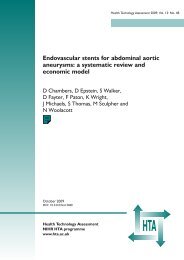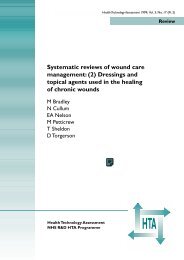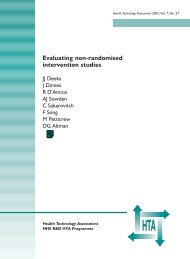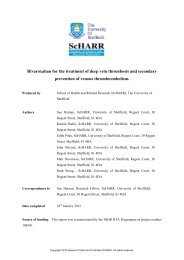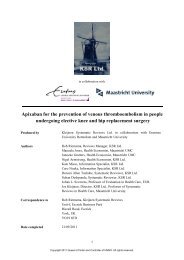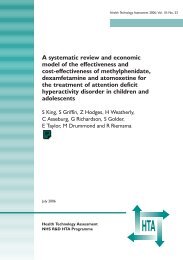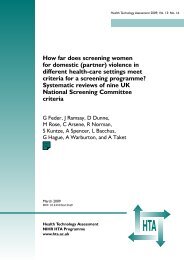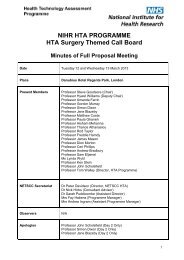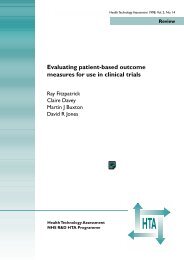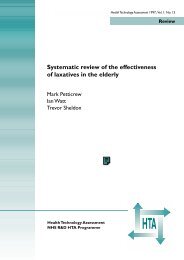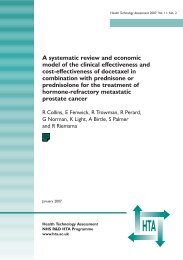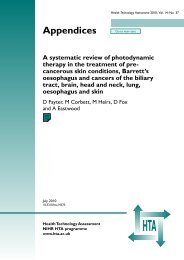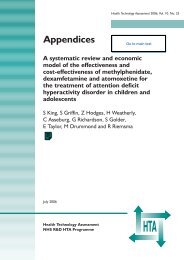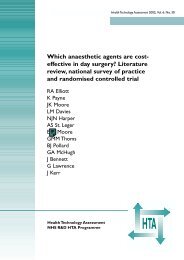Donepezil, rivastigmine, galantamine and memantine for ...
Donepezil, rivastigmine, galantamine and memantine for ...
Donepezil, rivastigmine, galantamine and memantine for ...
You also want an ePaper? Increase the reach of your titles
YUMPU automatically turns print PDFs into web optimized ePapers that Google loves.
112<br />
Economic analysis<br />
vascular dementia. The study examines the<br />
relationship between disease progression (using<br />
MMSE scores <strong>and</strong> the Barthel Index) <strong>and</strong> the cost<br />
of care. Patients were recruited to a study of<br />
behaviour in dementia. 155,156 The cohort was<br />
based in Ox<strong>for</strong>dshire, UK, <strong>and</strong> at the start of the<br />
study the patients were living at home with a carer<br />
able to give detailed in<strong>for</strong>mation about the<br />
patient. Patients (with carer support/input) were<br />
assessed at 4-monthly intervals between 1988–89<br />
<strong>and</strong> 1999. Assessment covered cognition,<br />
behaviour, ADL, carer in<strong>for</strong>mation <strong>and</strong> an<br />
assessment of resource use <strong>for</strong> health, social <strong>and</strong><br />
long-term services, including the setting of care.<br />
Subjects were classed as institutionalised when<br />
they were admitted to a hospital ward or a nursing<br />
home <strong>for</strong> permanent care. Items of resource use<br />
subject to data collection were hospitalisations,<br />
respite care, outpatient treatment, day care, home<br />
care by district nurses, community psychiatric<br />
nurses, home help, home care assistants, GP<br />
<strong>and</strong>/or practice nurse visits. Additionally, the use<br />
of special aids, adaptations, incontinence products<br />
<strong>and</strong> special dietary requirements were noted. Drug<br />
costs do not appear to have been included in the<br />
analysis, although up to 1999 treatment of AD had<br />
been largely palliative. Unit costs (1998 prices)<br />
were matched to resource use profiles <strong>and</strong> the<br />
study reports cost estimates on the basis of a fixedeffects<br />
regression model.<br />
Wolstenholme <strong>and</strong> colleagues report the total cost<br />
per patient over the course of the study to be<br />
£66,697 (SD £60,249), based on a mean follow-up<br />
over 40 months (range 1–132). Institutional care<br />
accounted <strong>for</strong> 69% of total cost. The authors also<br />
report cost by disease severity categories defined<br />
using MMSE <strong>and</strong> by Barthel Index categories;<br />
data by MMSE score are presented in Table 61.<br />
Cost pattern by Barthel Index categories showed a<br />
broadly similar pattern, increasing with severity.<br />
When examining the impact of different variables<br />
on the total costs of care, the authors report that<br />
ADL (Barthel Index scores) seemed to have a<br />
TABLE 61 Estimated annual cost by MMSE score, reported by Wolstenholme <strong>and</strong> colleagues 122<br />
much greater impact than cognitive changes on<br />
the health <strong>and</strong> social care resources used, with a<br />
1-point decline in MMSE associated with a £56<br />
increase in 4-monthly costs, compared with a £586<br />
increase in cost associated with a 1-point fall in the<br />
Barthel Index (event allowing <strong>for</strong> the shorter<br />
range in the Barthel Index). The authors also<br />
report that institutionalisation is associated with an<br />
additional 4-monthly cost of £8000. The analysis<br />
also examines the impact of variables on the time<br />
to institutionalisation, <strong>and</strong> one of the key findings<br />
of this study is that it may be inappropriate to<br />
model disease progression in dementia solely on<br />
the basis of measures of cognitive change.<br />
Netten <strong>and</strong> colleagues 130 present cost estimates <strong>for</strong><br />
elderly people with cognitive impairment, based<br />
on two surveys commissioned by the UK<br />
Department of Health: a longitudinal survey of<br />
publicly funded admission <strong>for</strong> those aged<br />
≥ 65 years (over 2500 persons) to residential <strong>and</strong><br />
nursing home care, <strong>and</strong> a cross-sectional survey of<br />
homes <strong>for</strong> elderly people (in<strong>for</strong>mation on 11,900<br />
residents). The surveys were not specific to AD or<br />
to patients with cognitive impairment, but data<br />
were available on cognitive impairment <strong>and</strong><br />
challenging behaviour via the Minimum Data Set<br />
(MDS) framework, using the MDS Cognitive<br />
Per<strong>for</strong>mance Scale (CPS), a seven-point scale<br />
providing in<strong>for</strong>mation on short-term memory loss,<br />
decision-making, communication <strong>and</strong> dependency.<br />
The MDS CPS has been shown to correspond<br />
closely to the MMSE. 157<br />
Netten <strong>and</strong> colleagues present findings on the<br />
weekly prices across residential care settings, with<br />
indications of differences <strong>for</strong> those severely<br />
cognitively impaired compared with all residents.<br />
Prices (1998–99 levels) did not differ greatly<br />
between privately <strong>and</strong> publicly funded settings.<br />
Nursing homes <strong>and</strong> dual-registered homes were<br />
more expensive than private <strong>and</strong> voluntary<br />
residential homes. Table 62 presents findings from<br />
Netten <strong>and</strong> colleagues on the weekly costs in the<br />
residential settings examined.<br />
AD severity MMSE score Estimated annual cost (1998 prices):<br />
mean (SD) (£)<br />
Mild >20 8,312 (5,602)<br />
Mild to moderate 15–20 11,643 (7,808)<br />
Moderate 10–14 15,681 (9,509)<br />
Severe



